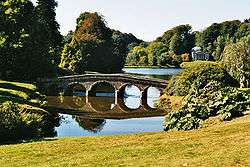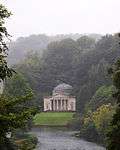Stourhead


Stourhead (/ˈstɑːˌhɛd/[1]) is a 1,072-hectare (2,650-acre) estate[2] at the source of the River Stour near Mere, Wiltshire, England. The estate includes a Palladian mansion, the village of Stourton, gardens, farmland, and woodland. Stourhead is part owned with the National Trust since 1946.
History
The Stourton family, the Barons of Stourton, had lived in the Stourhead estate for 500 years[3] until they sold it to Sir Thomas Meres in 1714.[4] His son, John Meres, sold it to Henry Hoare I, son of wealthy banker Sir Richard Hoare in 1717.[5] The original manor house was demolished and a new house, one of the first of its kind, was designed by Colen Campbell and built by Nathaniel Ireson between 1721 and 1725.[6] Over the next 200 years the Hoare family collected many heirlooms, including a large library and art collection. In 1902 the house was gutted by fire but many of the heirlooms were saved, and the house was rebuilt in a near identical style.[7]
The last Hoare family member to own the property, Henry Hugh Arthur Hoare, gave the house and gardens to the National Trust in 1946, one year before his death; his sole heir and son, Captain "Harry" Henry Colt Arthur Hoare, of the Queen's Own Dorset Yeomanry, had died of wounds received at the Battle of Mughar Ridge on 13 November 1917 in World War I.[7] The last Hoare family member to be born at the house was Edward Hoare on 11 October 1949.
Gardens
Architects
Although the main design for the estate at Stourhead was created by Colen Campbell, there were various other architects involved in its evolution through the years. William Benson, Henry Hoare's brother-in-law, was in part responsible for the building of the estate in 1719.[8] Francis Cartwright, a master builder and architect, was established as a "competent provincial designer in the Palladian manner."[9] He worked on Stourhead between the years of 1749–1755. Cartwright was a known carver, presumably of materials such as wood and stone. It is assumed that his contribution to Stourhead was in this capacity. Nathaniel Ireson is the master builder credited for much of the work on the Estate. It is this work that established his career, in 1720.[10]
The original estate remained intact, though changes and additions were made over time. Henry Flitcroft built three temples and a tower on the property. The Temple of Ceres was added in 1744, followed by the Temple of Hercules in 1754 and the Temple of Apollo in 1765. That same year he designed Alfred's Tower, but it wasn't built until 1772.[11] In 1806, the mason and surveyor John Carter added an ornamental cottage to the grounds; at the request of Sir Richard Colt Hoare.[12] The architect William Wilkins created a Grecian style lodge in 1816; for Sir R. Colt Hoare.[12]
In 1840, over a century after the initial buildings were constructed, Charles Parker was hired by Sir Hugh Hoare to make changes to the estate. A portico was added to the main house, along with other alterations. The design of the additions was in keeping with original plans.[13]
"The Genius of the Place"
The lake at Stourhead is artificially created. Following a path around the lake is meant to evoke a journey similar to that of Aeneas's descent in to the underworld.[14] In addition to Greek mythology, the layout is evocative of the "genius of the place", a concept made famous by Alexander Pope. Buildings and monuments are erected in remembrance of family and local history. Henry Hoare was a collector of art– one of his pieces was Claude Lorrain's Aeneas at Delos, which is thought to have inspired the pictorial design of the gardens.[14] Passages telling of Aeneas's journey are quoted in the temples surrounding the lake.
Monuments are used to frame one another; for example the Pantheon designed by Flitcroft entices the visitor over, but once reached, views from the opposite shore of the lake beckon.[15] The use of the sunken path allows the landscape to continue on into neighbouring landscapes, allowing the viewer to contemplate all the surrounding panorama. The Pantheon was thought to be the most important visual feature of the gardens. It appears in many pieces of artwork owned by Hoare, depicting Aeneas's travels.[16] The plantings in the garden were arranged in a manner that would evoke different moods, drawing visitors through realms of thought.[15] According to Henry Hoare, 'The greens should be ranged together in large masses as the shades are in painting: to contrast the dark masses with the light ones, and to relieve each dark mass itself with little sprinklings of lighter greens here and there.'[17]
The gardens were designed by Henry Hoare II and laid out between 1741 and 1780 in a classical 18th-century design set around a large lake, achieved by damming a small stream. The inspiration behind their creation were the painters Claude Lorrain, Poussin, and, in particular, Gaspard Dughet, who painted Utopian-type views of Italian landscapes. It is similar in style to the landscape gardens at Stowe.
Included in the garden are a number of temples inspired by scenes of the Grand Tour of Europe. On one hill overlooking the gardens there stands an obelisk and King Alfred's Tower, a 50-metre-tall, brick folly designed by Henry Flitcroft in 1772; on another hill the temple of Apollo provides a vantage point to survey the magnificent rhododendrons, water, cascades and temples. The large medieval Bristol High Cross was moved from Bristol to the gardens. Amongst the hills surrounding the site there are also two Iron Age hill forts: Whitesheet Hill and Park Hill Camp. The gardens are home to a large collection of trees and shrubs from around the world.
Richard Colt Hoare, the grandson of Henry Hoare II, inherited Stourhead in 1783.[7] He added the library wing to the mansion,[7] and in the garden was responsible for the building of the boathouse and the removal of several features that were not in keeping with the classical and gothic styles (including a Turkish Tent). He also considerably enhanced the planting – the Temple of Apollo rises from a wooded slope that was planted in Colt Hoare's time. With the antiquarian passion of the times, he had 400 ancient burial mounds dug up to inform his pioneering History of Ancient Wiltshire.[18]
Prints
Henry Hoare’s art collection is displayed at Stourhead; his acquisitions are featured in the Palladian mansion’s ‘Painted Alcove’ or Italian Room. Hoare’s collection includes many hand-coloured prints – in some cases, coloured with such skill that they were mistaken for oil paintings. These prints are engravings of the works of the Italian masters (for example Daniele da Volterra, and Carlo Maratta) and the hand-colouring is attributed to a “Mr. Studio”, thought to be Giacomo Van Lint, the son of Flemish painter Hendrik van Lint (possibly in collaboration with his father).[19]
Trivia
- A miniature replica of Stourhead House featured as Lady Penelope Creighton-Ward's mansion in the Thunderbirds television series.
- Temple of Apollo and Palladian Bridge can be seen in the 2005 movie Pride & Prejudice.
- Stourhead House was featured on the cover of English indie rock band Milburn's single "What Will You Do (When The Money Goes)?"
- The gardens were used in the film Barry Lyndon.
- The estate was at one point garrisoned for the king, during the lifetime of the 11th Baron Stourton, who was a royalist.
- The house was ravaged, in September 1644, by General Ludlow.
- The National Trust's corporate font, designed by Paul Barnes, is based on an inscription in the grotto, created around 1748.[20][21][22] Unfortunately, the inscription was destroyed by mistake around the 1960s and a replica had to be made from photographs.[23][24]
Gallery
- Entrance front
 Library
Library Bridge and Pantheon
Bridge and Pantheon The Pantheon
The Pantheon Statue in Pantheon
Statue in Pantheon- Temple of Flora and Bridge
 View from Grotto
View from Grotto Sleeping nymph statue in the Grotto
Sleeping nymph statue in the Grotto.jpg) Grotto text, a quotation from Pope
Grotto text, a quotation from Pope Temple of Apollo
Temple of Apollo The Lake
The Lake Rhododendrons in flower
Rhododendrons in flower Temple of Apollo from the lake
Temple of Apollo from the lake

References
- Notes
- ↑ "Stourhead". Oxford Advanced Learner's Dictionary. Retrieved 11 September 2012.
- ↑ "National Trust – Stourhead". National Trust. Retrieved 19 April 2012.
- ↑ Dodd 1981, p. 31
- ↑ Dodd 1981, p. 33
- ↑ Dodd 1981, p. 34
- ↑ Dodd 1981, p. 6
- 1 2 3 4 Dodd 1981, p. 4
- ↑ Colvin 1997, p. 123
- ↑ Colvin 1997, p. 231
- ↑ Colvin 1997, p. 529
- ↑ Colvin 1997, p. 368
- 1 2 Colvin 1997, p. 230
- ↑ Colvin 1997, p. 1058
- 1 2 Bergdoll 2000, p. 77
- 1 2 Bergdoll 2000, p. 78
- ↑ Woodbridge 1970, pp. 31–33
- ↑ Woodbridge 1970, p. 31
- ↑ Times Literary Supplement, 12 October 2007, p. 4
- ↑ Dodd, Dudley (September 2016). "'Mr Studio's' Hand-Coloured Prints at Stourhead". Print Quarterly. XXXIII (3).
- ↑ "New look National Trust magazine rolls out". The Drum. Retrieved 23 September 2016.
- ↑ "National Trust branding". Luke Charles. Retrieved 23 September 2016.
- ↑ National Trust Brand Standards (PDF). National Trust. 2014. pp. 30–33.
- ↑ Barnes, Paul. "James Mosley: A Life in Objects". Eye. Retrieved 23 September 2016.
- ↑ Mosley, James (1999). The nymph and the grot: the revival of the sanserif letter. London: Friends of the St Bride Printing Library. pp. 1–19. ISBN 9780953520107.
- Bibliography
- Bergdoll, Barry (2000). European Architecture: 1750–1890 (1st ed.). Oxford: Oxford University Press. p. 77. ISBN 0-19-284222-6.
- Colvin, H.M. (1997). A Biographical Dictionary of British Architects, 1600–1840 (3rd ed.). New Haven: Yale University Press. ISBN 0-300-07207-4.
- Dodd, Dudley (1981). Stourhead. The National Trust.
- Hussey, C. (1956). English country houses: Mid Georgian, 1760–1800. pp. 234–8.
- Woodbridge, Kenneth (2001) [1982]. The Stourhead Landscape. National Trust.
- Woodbridge, Kenneth (1970). Landscape and Antiquity Aspects of English Culture at Stourhead: 1718–1838. Oxford: Clarendon.
External links
| Wikimedia Commons has media related to Stourhead. |
- Stourhead information at the National Trust
- Stourhead entry from The DiCamillo Companion to British & Irish Country Houses
- Estate remembers cavalry action 11 Nov 2007 from BBC News
Coordinates: 51°6′22″N 02°19′4″W / 51.10611°N 2.31778°W